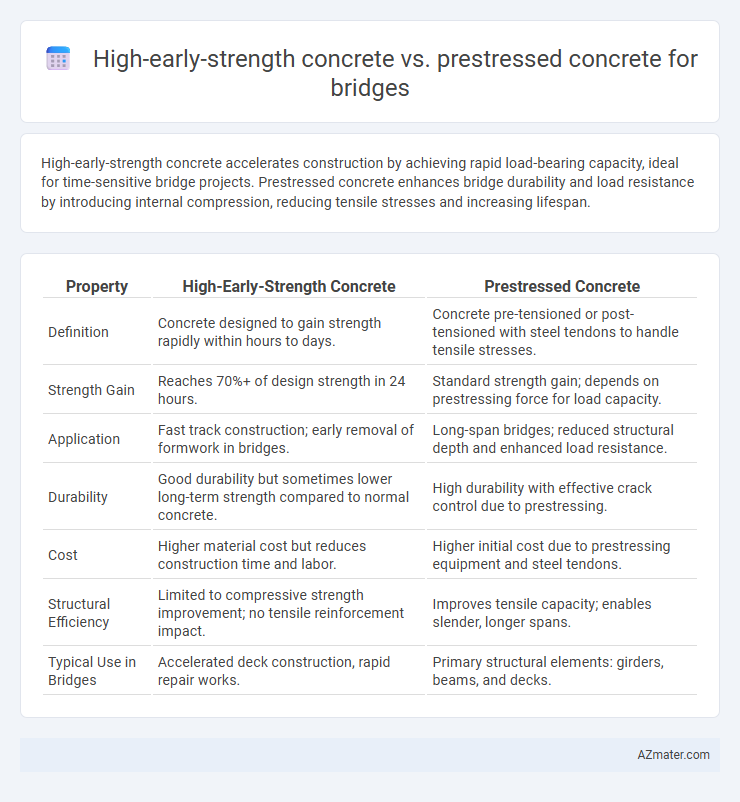High-early-strength concrete accelerates construction by achieving rapid load-bearing capacity, ideal for time-sensitive bridge projects. Prestressed concrete enhances bridge durability and load resistance by introducing internal compression, reducing tensile stresses and increasing lifespan.
Table of Comparison
| Property | High-Early-Strength Concrete | Prestressed Concrete |
|---|---|---|
| Definition | Concrete designed to gain strength rapidly within hours to days. | Concrete pre-tensioned or post-tensioned with steel tendons to handle tensile stresses. |
| Strength Gain | Reaches 70%+ of design strength in 24 hours. | Standard strength gain; depends on prestressing force for load capacity. |
| Application | Fast track construction; early removal of formwork in bridges. | Long-span bridges; reduced structural depth and enhanced load resistance. |
| Durability | Good durability but sometimes lower long-term strength compared to normal concrete. | High durability with effective crack control due to prestressing. |
| Cost | Higher material cost but reduces construction time and labor. | Higher initial cost due to prestressing equipment and steel tendons. |
| Structural Efficiency | Limited to compressive strength improvement; no tensile reinforcement impact. | Improves tensile capacity; enables slender, longer spans. |
| Typical Use in Bridges | Accelerated deck construction, rapid repair works. | Primary structural elements: girders, beams, and decks. |
Introduction to Bridge Construction Materials
High-early-strength concrete achieves rapid strength gain, enabling faster bridge construction and reduced formwork time, ideal for accelerated project schedules. Prestressed concrete incorporates tensioned steel strands to counteract tensile stresses, enhancing load-bearing capacity and durability in bridge spans. Both materials are pivotal in modern bridge construction, chosen based on project requirements such as load demands, construction speed, and structural performance.
Overview of High-Early-Strength Concrete
High-early-strength concrete exhibits rapid strength gain within the first 24 to 48 hours, reaching compressive strengths above 20 MPa significantly faster than conventional concrete, ideal for accelerated bridge construction and reduced formwork time. This type of concrete incorporates high-grade cement, supplementary cementitious materials, and chemical admixtures to optimize hydration and early strength development, enhancing durability and load-carrying capacity in bridge decks and girders. Its application in bridges supports quicker traffic reopening and decreases construction time compared to prestressed concrete, which relies on tensioned steel tendons to improve performance over standard concrete.
Understanding Prestressed Concrete
Prestressed concrete enhances bridge performance by introducing internal compressive stresses through tensioned steel tendons before service loads are applied, significantly improving load-bearing capacity and crack resistance compared to high-early-strength concrete. Unlike high-early-strength concrete, which gains strength rapidly to expedite construction schedules, prestressed concrete provides superior structural efficiency for long-span bridges by controlling deflections and reducing material usage. Understanding the mechanics of prestressed concrete is crucial for optimizing bridge design, ensuring durability, and managing tensile stresses that conventional concrete cannot resist effectively.
Key Properties and Performance Factors
High-early-strength concrete offers rapid strength gain, enabling faster construction schedules and early load application on bridges, with compressive strengths typically exceeding 20 MPa within 24 hours. Prestressed concrete enhances structural performance by introducing internal stresses that counteract tensile forces, improving durability, reducing cracking, and allowing longer spans. Key performance factors include early strength development for high-early-strength concrete, and tension preloading and creep behavior management for prestressed concrete to ensure long-term stability and load capacity.
Speed of Construction and Project Timelines
High-early-strength concrete accelerates bridge construction by reaching significant strength in 24 hours, reducing curing time and allowing faster formwork removal. Prestressed concrete shortens project timelines by enabling longer spans with fewer supports, minimizing construction stages and enhancing load capacity. Combining high-early-strength concrete with prestressed techniques maximizes speed, optimizing bridge delivery schedules efficiently.
Load-Bearing Capacity and Structural Performance
High-early-strength concrete achieves rapid strength gain, enabling faster load-bearing capacity development critical for accelerating bridge construction schedules. Prestressed concrete incorporates tensioned steel tendons, significantly enhancing tensile strength and overall structural performance by minimizing cracks and deflections under load. Both materials improve durability and load capacity, but prestressed concrete offers superior resistance to bending moments and shear forces, making it ideal for longer-span bridge components.
Durability and Long-Term Maintenance
High-early-strength concrete achieves rapid strength gain, allowing faster bridge construction and early load application, but may have reduced long-term durability due to higher shrinkage and cracking potential. Prestressed concrete enhances durability by minimizing tensile stresses through pre-applied compression, reducing crack formation and improving structural integrity over time. Long-term maintenance costs are typically lower for prestressed bridges as their design mitigates deterioration mechanisms, whereas high-early-strength concrete bridges may require more frequent repairs to address durability-related issues.
Cost Comparison and Economic Considerations
High-early-strength concrete reduces construction time by achieving rapid load-bearing capacity, leading to decreased labor and equipment rental costs, which can significantly lower overall project expenses compared to traditional concretes. Prestressed concrete, while typically more expensive in material and fabrication costs due to steel tendons and specialized construction techniques, offers longer spans and enhanced durability, resulting in lower maintenance expenses over the bridge's lifespan. Evaluating the economic trade-offs between initial costs and life-cycle costs is critical when choosing between high-early-strength and prestressed concrete for bridge projects.
Common Applications in Bridge Engineering
High-early-strength concrete is commonly used in bridge construction for rapid repair and accelerated project timelines, allowing early removal of formwork and quicker load application. Prestressed concrete finds extensive application in long-span bridges, including beam, box girder, and segmental bridge designs, enhancing load-carrying capacity and reducing deflection. Both materials optimize structural performance, with high-early-strength concrete suited for fast-track projects and prestressed concrete preferred in bridges requiring enhanced tensile strength and durability.
Choosing the Right Concrete Solution for Bridges
High-early-strength concrete accelerates bridge construction by achieving rapid load-bearing capacity, reducing formwork time and enabling faster project completion. Prestressed concrete enhances structural performance through pre-tensioning or post-tensioning steel tendons, allowing longer spans and improved crack resistance under heavy loads. Selecting the right concrete solution balances project timelines, design requirements, load conditions, and durability needs, ensuring optimal bridge safety and longevity.

Infographic: High-early-strength concrete vs Prestressed concrete for Bridge
 azmater.com
azmater.com